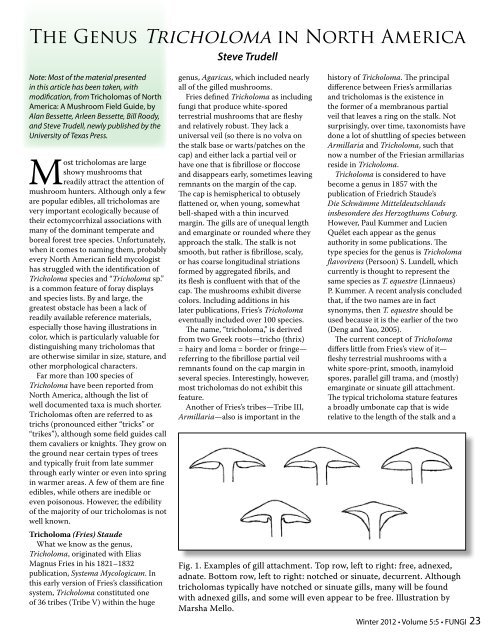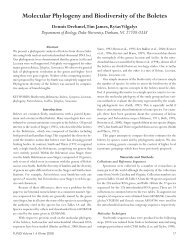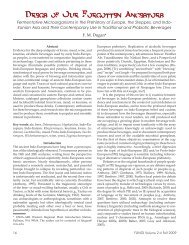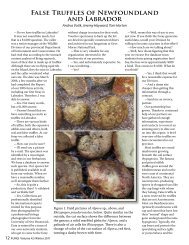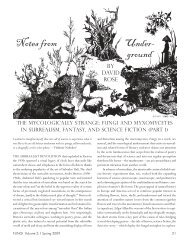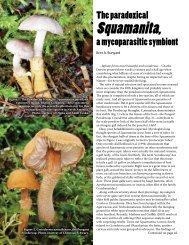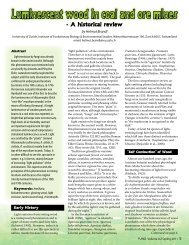The Genus Tricholoma in North America
The Genus Tricholoma in North America
The Genus Tricholoma in North America
Create successful ePaper yourself
Turn your PDF publications into a flip-book with our unique Google optimized e-Paper software.
<strong>The</strong> <strong>Genus</strong> <strong>Tricholoma</strong> <strong>in</strong> <strong>North</strong> <strong>America</strong><br />
Steve Trudell<br />
Note: Most of the material presented<br />
<strong>in</strong> this article has been taken, with<br />
modification, from <strong>Tricholoma</strong>s of <strong>North</strong><br />
<strong>America</strong>: A Mushroom Field Guide, by<br />
Alan Bessette, Arleen Bessette, Bill Roody,<br />
and Steve Trudell, newly published by the<br />
University of Texas Press.<br />
Most tricholomas are large<br />
showy mushrooms that<br />
readily attract the attention of<br />
mushroom hunters. Although only a few<br />
are popular edibles, all tricholomas are<br />
very important ecologically because of<br />
their ectomycorrhizal associations with<br />
many of the dom<strong>in</strong>ant temperate and<br />
boreal forest tree species. Unfortunately,<br />
when it comes to nam<strong>in</strong>g them, probably<br />
every <strong>North</strong> <strong>America</strong>n field mycologist<br />
has struggled with the identification of<br />
<strong>Tricholoma</strong> species and “<strong>Tricholoma</strong> sp.”<br />
is a common feature of foray displays<br />
and species lists. By and large, the<br />
greatest obstacle has been a lack of<br />
readily available reference materials,<br />
especially those hav<strong>in</strong>g illustrations <strong>in</strong><br />
color, which is particularly valuable for<br />
dist<strong>in</strong>guish<strong>in</strong>g many tricholomas that<br />
are otherwise similar <strong>in</strong> size, stature, and<br />
other morphological characters.<br />
Far more than 100 species of<br />
<strong>Tricholoma</strong> have been reported from<br />
<strong>North</strong> <strong>America</strong>, although the list of<br />
well documented taxa is much shorter.<br />
<strong>Tricholoma</strong>s often are referred to as<br />
trichs (pronounced either “tricks” or<br />
“trikes”), although some field guides call<br />
them cavaliers or knights. <strong>The</strong>y grow on<br />
the ground near certa<strong>in</strong> types of trees<br />
and typically fruit from late summer<br />
through early w<strong>in</strong>ter or even <strong>in</strong>to spr<strong>in</strong>g<br />
<strong>in</strong> warmer areas. A few of them are f<strong>in</strong>e<br />
edibles, while others are <strong>in</strong>edible or<br />
even poisonous. However, the edibility<br />
of the majority of our tricholomas is not<br />
well known.<br />
<strong>Tricholoma</strong> (Fries) Staude<br />
What we know as the genus,<br />
<strong>Tricholoma</strong>, orig<strong>in</strong>ated with Elias<br />
Magnus Fries <strong>in</strong> his 1821–1832<br />
publication, Systema Mycologicum. In<br />
this early version of Fries’s classification<br />
system, <strong>Tricholoma</strong> constituted one<br />
of 36 tribes (Tribe V) with<strong>in</strong> the huge<br />
genus, Agaricus, which <strong>in</strong>cluded nearly<br />
all of the gilled mushrooms.<br />
Fries def<strong>in</strong>ed <strong>Tricholoma</strong> as <strong>in</strong>clud<strong>in</strong>g<br />
fungi that produce white-spored<br />
terrestrial mushrooms that are fleshy<br />
and relatively robust. <strong>The</strong>y lack a<br />
universal veil (so there is no volva on<br />
the stalk base or warts/patches on the<br />
cap) and either lack a partial veil or<br />
have one that is fibrillose or floccose<br />
and disappears early, sometimes leav<strong>in</strong>g<br />
remnants on the marg<strong>in</strong> of the cap.<br />
<strong>The</strong> cap is hemispherical to obtusely<br />
flattened or, when young, somewhat<br />
bell-shaped with a th<strong>in</strong> <strong>in</strong>curved<br />
marg<strong>in</strong>. <strong>The</strong> gills are of unequal length<br />
and emarg<strong>in</strong>ate or rounded where they<br />
approach the stalk. <strong>The</strong> stalk is not<br />
smooth, but rather is fibrillose, scaly,<br />
or has coarse longitud<strong>in</strong>al striations<br />
formed by aggregated fibrils, and<br />
its flesh is confluent with that of the<br />
cap. <strong>The</strong> mushrooms exhibit diverse<br />
colors. Includ<strong>in</strong>g additions <strong>in</strong> his<br />
later publications, Fries’s <strong>Tricholoma</strong><br />
eventually <strong>in</strong>cluded over 100 species.<br />
<strong>The</strong> name, “tricholoma,” is derived<br />
from two Greek roots—tricho (thrix)<br />
= hairy and loma = border or fr<strong>in</strong>ge—<br />
referr<strong>in</strong>g to the fibrillose partial veil<br />
remnants found on the cap marg<strong>in</strong> <strong>in</strong><br />
several species. Interest<strong>in</strong>gly, however,<br />
most tricholomas do not exhibit this<br />
feature.<br />
Another of Fries’s tribes—Tribe III,<br />
Armillaria—also is important <strong>in</strong> the<br />
history of <strong>Tricholoma</strong>. <strong>The</strong> pr<strong>in</strong>cipal<br />
difference between Fries’s armillarias<br />
and tricholomas is the existence <strong>in</strong><br />
the former of a membranous partial<br />
veil that leaves a r<strong>in</strong>g on the stalk. Not<br />
surpris<strong>in</strong>gly, over time, taxonomists have<br />
done a lot of shuttl<strong>in</strong>g of species between<br />
Armillaria and <strong>Tricholoma</strong>, such that<br />
now a number of the Friesian armillarias<br />
reside <strong>in</strong> <strong>Tricholoma</strong>.<br />
<strong>Tricholoma</strong> is considered to have<br />
become a genus <strong>in</strong> 1857 with the<br />
publication of Friedrich Staude’s<br />
Die Schwämme Mitteldeutschlands<br />
<strong>in</strong>sbesondere des Herzogthums Coburg.<br />
However, Paul Kummer and Lucien<br />
Quélet each appear as the genus<br />
authority <strong>in</strong> some publications. <strong>The</strong><br />
type species for the genus is <strong>Tricholoma</strong><br />
flavovirens (Persoon) S. Lundell, which<br />
currently is thought to represent the<br />
same species as T. equestre (L<strong>in</strong>naeus)<br />
P. Kummer. A recent analysis concluded<br />
that, if the two names are <strong>in</strong> fact<br />
synonyms, then T. equestre should be<br />
used because it is the earlier of the two<br />
(Deng and Yao, 2005).<br />
<strong>The</strong> current concept of <strong>Tricholoma</strong><br />
differs little from Fries’s view of it—<br />
fleshy terrestrial mushrooms with a<br />
white spore-pr<strong>in</strong>t, smooth, <strong>in</strong>amyloid<br />
spores, parallel gill trama, and (mostly)<br />
emarg<strong>in</strong>ate or s<strong>in</strong>uate gill attachment.<br />
<strong>The</strong> typical tricholoma stature features<br />
a broadly umbonate cap that is wide<br />
relative to the length of the stalk and a<br />
Fig. 1. Examples of gill attachment. Top row, left to right: free, adnexed,<br />
adnate. Bottom row, left to right: notched or s<strong>in</strong>uate, decurrent. Although<br />
tricholomas typically have notched or s<strong>in</strong>uate gills, many will be found<br />
with adnexed gills, and some will even appear to be free. Illustration by<br />
Marsha Mello.<br />
W<strong>in</strong>ter 2012 • Volume 5:5 • FUNGI<br />
23
Fig. 2. <strong>Tricholoma</strong> subresplendens, one of the white-capped tricholomas. It<br />
is a W.A. Murrill species that is very similar to, or perhaps the same as, T.<br />
columbetta. Photo by Bill Roody.<br />
“gutter” around the stalk formed by the<br />
emarg<strong>in</strong>ate gills. Because the concept<br />
now is based <strong>in</strong> part on microscopic<br />
features (mostly their absence),<br />
sometimes it is necessary to use a<br />
microscope to be certa<strong>in</strong> that you<br />
have a tricholoma.<br />
In paperback<br />
February 1, 2013<br />
24 FUNGI • Volume 5:5 • W<strong>in</strong>ter 2012<br />
Although gill attachment is rarely,<br />
if ever, used to help differentiate<br />
species with<strong>in</strong> <strong>Tricholoma</strong>, it is an<br />
important character for recogniz<strong>in</strong>g the<br />
genus. Usually it is described as be<strong>in</strong>g<br />
emarg<strong>in</strong>ate, notched, or s<strong>in</strong>uate (Fig. 1).<br />
Unfortunately, gill attachment can be a<br />
rather variable feature and these terms<br />
have been <strong>in</strong>terpreted differently from<br />
mycologist to mycologist (Leonard,<br />
2000). C.H. Kauffman (1918) described<br />
the variability nearly a century ago.<br />
“<strong>The</strong>oretically, they (the gills) are always<br />
emarg<strong>in</strong>ate beh<strong>in</strong>d, but this condition<br />
varies considerably. It is true that, <strong>in</strong> the<br />
mature plant, when the pileus is fully<br />
expanded, they become either s<strong>in</strong>uate<br />
or emarg<strong>in</strong>ate <strong>in</strong> most cases, although<br />
a s<strong>in</strong>gle specimen may not always be<br />
normal <strong>in</strong> this respect. When young,<br />
however, they often do not show this<br />
character clearly, but are then adnexed,<br />
rounded-adnate, or adnate <strong>in</strong> such a way<br />
that they are merely a little less broad<br />
at the attached portion than they are<br />
a few millimeters from the stem, and<br />
this short distance is often marked by<br />
a straight edge rather than a rounded<br />
edge... In old stages the gills may even<br />
become spuriously decurrent.” Thus,<br />
when attempt<strong>in</strong>g to determ<strong>in</strong>e the gill<br />
attachment of a putative tricholoma, it<br />
is best to exam<strong>in</strong>e multiple specimens<br />
of different ages and to allow for some<br />
latitude <strong>in</strong> <strong>in</strong>terpretation.<br />
Macroscopic Features Used for<br />
Classify<strong>in</strong>g and Identify<strong>in</strong>g <strong>Tricholoma</strong>s<br />
Identification of tricholomas relies<br />
heavily on size of the fruitbody and<br />
macroscopic features of the cap such as<br />
color, the presence or absence of scales<br />
or radiat<strong>in</strong>g fibrils on the surface, and<br />
whether it is dry, moist, or viscid. Odor<br />
and taste of the flesh are sometimes<br />
def<strong>in</strong><strong>in</strong>g characters. <strong>The</strong> gills are white<br />
to off-white <strong>in</strong> most species but can also<br />
be grayish, buff, or yellow. Spott<strong>in</strong>g,<br />
sta<strong>in</strong><strong>in</strong>g, or discolor<strong>in</strong>g (often reddish<br />
brown) of the gills <strong>in</strong> age (or after<br />
damage) is a characteristic feature of<br />
many species.<br />
Size of the fruitbodies can vary with<strong>in</strong><br />
a species and so exact measurements<br />
are not always useful. However, “small,”<br />
“medium,” and “large,” based on the<br />
diameter of the mature caps, are handy<br />
descriptors. Typically, “small” refers to<br />
caps with diameter usually less than 5<br />
cm; “medium” to caps usually between<br />
5 and 10 cm, and “large” to caps usually<br />
greater than 10 cm.<br />
<strong>The</strong> stalk is usually more or less<br />
equal but may be swollen <strong>in</strong> the middle<br />
(ventricose), tapered downward, or<br />
enlarged to slightly bulbous at the<br />
base. It is fleshy or fibrous like the cap<br />
and can be solid, stuffed, or hollow. Its<br />
surface usually is dry and longitud<strong>in</strong>ally<br />
striate, but also can be nearly smooth,<br />
appressed-fibrillose, scaly, or slightly<br />
scurfy (at the apex only). Stalk color<br />
often is white, but it may be t<strong>in</strong>ged<br />
with the cap color, or, more rarely, fully<br />
concolorous with the cap.<br />
A number of tricholomas have a<br />
cort<strong>in</strong>a. In these species, the veil usually<br />
is delicate and may be visible only on<br />
very young specimens, leav<strong>in</strong>g just a<br />
trace of fibrils as a fa<strong>in</strong>t r<strong>in</strong>g-zone on the<br />
upper portion of the stalk or a fr<strong>in</strong>ged<br />
marg<strong>in</strong> on the cap. A few species have a<br />
more substantial membranous veil that<br />
leaves a more or less prom<strong>in</strong>ent r<strong>in</strong>g on<br />
the stalk.<br />
Sta<strong>in</strong><strong>in</strong>g of the cap surface or,<br />
more commonly, the gills and<br />
stalk, from bruis<strong>in</strong>g, handl<strong>in</strong>g, or<br />
with age is sometimes important<br />
<strong>in</strong> dist<strong>in</strong>guish<strong>in</strong>g between species.<br />
Color-change reactions follow<strong>in</strong>g<br />
the application of chemicals to the<br />
fruitbody (“macrochemical” reactions)<br />
are not used widely <strong>in</strong> identify<strong>in</strong>g
Fig. 3. <strong>Tricholoma</strong> arvernense, one of the yellow-capped<br />
tricholomas. It was added to the <strong>North</strong> <strong>America</strong>n list<br />
only recently when a DNA sequence from a collection<br />
made <strong>in</strong> Idaho by Andrew Parker was found to be<br />
nearly identical to that of European material. It also has<br />
been found <strong>in</strong> California, Oregon, Wash<strong>in</strong>gton, Alaska,<br />
and possibly Newfoundland. Photo by Sava Krstic.<br />
tricholomas, but can be important <strong>in</strong> some cases. Potassium<br />
hydroxide (KOH), ammonium hydroxide (NH4OH), and<br />
paradimethylam<strong>in</strong>obenzaldehyde (PDAB) are of most use.<br />
Common odors of tricholomas <strong>in</strong>clude far<strong>in</strong>aceous,<br />
cucumber, coal tar, and, of course, the matsutake’s spicy<br />
c<strong>in</strong>namon aroma. In many species, the odor is pleasant,<br />
although not easily describable. <strong>The</strong> more common tastes are<br />
mild, bitter, and far<strong>in</strong>aceous.<br />
In addition to these macromorphological features, know<strong>in</strong>g<br />
which species of tree the mushrooms were grow<strong>in</strong>g with can<br />
be critical for identify<strong>in</strong>g them. When found beneath isolated<br />
trees, or <strong>in</strong> more or less pure stands, the associate is fairly<br />
obvious. However <strong>in</strong> mixed woodlands conta<strong>in</strong><strong>in</strong>g a variety<br />
of ectomycorrhiza-form<strong>in</strong>g trees, it can be more difficult<br />
to determ<strong>in</strong>e a specific relationship. At a m<strong>in</strong>imum, it is<br />
important to know whether the nearby trees were conifers or<br />
hardwoods, and so this <strong>in</strong>formation should always be <strong>in</strong>cluded<br />
<strong>in</strong> your field notes.<br />
Microscopic Features Used for Classify<strong>in</strong>g and Identify<strong>in</strong>g<br />
<strong>Tricholoma</strong>s<br />
Microscopic features are important for dist<strong>in</strong>guish<strong>in</strong>g<br />
the genus <strong>Tricholoma</strong> from other genera that are similar<br />
macroscopically. However, they generally are less dist<strong>in</strong>ctive,<br />
less variable, and less helpful for dist<strong>in</strong>guish<strong>in</strong>g species <strong>in</strong><br />
<strong>Tricholoma</strong> than they are <strong>in</strong> many other genera. <strong>The</strong> spores<br />
are smooth and non-amyloid, cystidia are present only <strong>in</strong><br />
some species (then usually cheilocystidia), and cap cuticle<br />
usually is radially filamentous. <strong>The</strong> shape and size of the<br />
spores and cystidia, the presence of clamp connections, and<br />
the structure of the cap cuticle (especially the presence of a<br />
so-called pseudoparenchymatous hypodermium) are the most<br />
commonly used microscopic features.<br />
Fig. 4. <strong>Tricholoma</strong> floridanum, another of the yellowcapped<br />
tricholomas. This is one of the many not-wellknown<br />
species described by W.A. Murrill from Florida.<br />
Photo by Alan and Arleen Bessette.<br />
Morphologically Similar Genera<br />
Follow<strong>in</strong>g Fries’s <strong>in</strong>itial def<strong>in</strong>ition of <strong>Tricholoma</strong>, some<br />
of the species he <strong>in</strong>cluded <strong>in</strong> the genus were transferred to<br />
other exist<strong>in</strong>g or newly created genera, such as Calocybe,<br />
Dermoloma, Lepista/Rhodopaxillus, Leucopaxillus,<br />
Lyophyllum, Melanoleuca, Porpoloma, Rhodocybe, Tephrocybe,<br />
Tricholomopsis, and Tricholosporum. Because many of the<br />
mushrooms <strong>in</strong> these pale-spored genera share the essential<br />
macroscopic features of tricholoma, they can be mistaken for a<br />
tricholoma. Thus, the follow<strong>in</strong>g brief descriptions summarize<br />
the key features for dist<strong>in</strong>guish<strong>in</strong>g them from tricholomas.<br />
Amanita—universal veil present, leav<strong>in</strong>g a volva on the<br />
stalk base, and often warts or patches on the cap; skirt-like<br />
r<strong>in</strong>g often present; gills free or nearly so, often seced<strong>in</strong>g. Cap<br />
marg<strong>in</strong> often striate. Most have an elegant gestalt, not easily<br />
described, but readily appreciated with a bit of experience.<br />
Armillaria (the honey mushrooms, formerly armillariella)—<br />
usually found on wood, often <strong>in</strong> clusters, tough black<br />
“bootlace” rhizomorphs often present <strong>in</strong> substrate, the<br />
typical honey colors of their fruitbodies are rare or absent <strong>in</strong><br />
tricholomas, gills adnate to decurrent.<br />
Calocybe—white or brightly colored fruitbodies, basidia<br />
conta<strong>in</strong> siderophilous granules, spores sometimes roughened,<br />
cap cuticle sometimes cellular.<br />
Catathelasma—large, hard-textured mushrooms, adnate to<br />
decurrent gills, stalk tapered downward and with double r<strong>in</strong>g,<br />
amyloid spores.<br />
Clitocybe—gills usually decurrent and fruitbodies often<br />
funnel-shaped, at least at maturity.<br />
Collybia sensu lato (<strong>in</strong>clud<strong>in</strong>g gymnopus and<br />
rhodocollybia)—cap marg<strong>in</strong> <strong>in</strong>curved to <strong>in</strong>rolled (at least when<br />
young), stalk with a cartilag<strong>in</strong>ous r<strong>in</strong>d, gills adnexed to adnate,<br />
spores usually p<strong>in</strong>kish <strong>in</strong> rhodocollybia.<br />
Dermoloma—smallish fruitbodies, cap cuticle hymeniform<br />
(radially filamentous <strong>in</strong> tricholomas), spores amyloid <strong>in</strong> some<br />
species.<br />
Floccularia—spores amyloid, stalks typically floccose,<br />
usually with a membranous r<strong>in</strong>g.<br />
Hygrophorus (sensu stricto, the medium to large, mostly<br />
W<strong>in</strong>ter 2012 • Volume 5:5 • FUNGI<br />
25
Fig. 5. <strong>Tricholoma</strong> “quercetorum," another yellowcapped<br />
species. As the epithet suggests, it occurs with<br />
oaks. It has not yet been described formally and, when<br />
it does, it will need a new epithet as "quercetorum"<br />
already is <strong>in</strong> use for a different (European) species.<br />
Photo by Noah Siegel.<br />
dull-colored species)—gills thick and waxy-look<strong>in</strong>g, adnate to<br />
decurrent, gill trama divergent when young.<br />
Laccaria—fruitbodies with dist<strong>in</strong>ctive orange-brown, p<strong>in</strong>kishbrown,<br />
or purplish colors that are rare or absent <strong>in</strong> <strong>Tricholoma</strong>s,<br />
gills thick and waxy-look<strong>in</strong>g, usually p<strong>in</strong>kish brown, lilac, or<br />
purple, stalk rather tough and fibrous, spores sp<strong>in</strong>y.<br />
Lepista—spore-pr<strong>in</strong>t with p<strong>in</strong>kish tones, spores roughened.<br />
Leucopaxillus—abundant mycelial cords or mat often<br />
present at base of stalk, fruitbodies often very firm and slow to<br />
rot, spores amyloid, sometimes roughened.<br />
Lyophyllum (<strong>in</strong>clud<strong>in</strong>g tephrocybe)—basidia conta<strong>in</strong><br />
siderophilous granules, fruitbodies usually dull colored and<br />
often with greasy appearance, many species sta<strong>in</strong> black.<br />
Megacollybia—usually found on wood (may be well rotted),<br />
gills rather broad, their edges with abundant cystidia.<br />
Melanoleuca—cap hygrophanous and often broad relative<br />
to stalk length, spores amyloid, roughened, gills usually with<br />
abundant cystidia.<br />
Porpoloma—spores amyloid, gill edges typically with<br />
cystidia.<br />
Tricholomopsis—usually found on wood, often bright<br />
yellowish, gill edges often with abundant cystidia.<br />
Tricholosporum—spores angular, or shaped like crosses.<br />
In addition to these pale-spored genera, many entolomas<br />
and hebelomas have the same stature as a typical tricholoma.<br />
However, they are easily recognized by their salmon/p<strong>in</strong>kish<br />
brown and dull brown spores, respectively. Small brownish<br />
tricholomas can appear very <strong>in</strong>ocybe-like but, aga<strong>in</strong>, sporecolor<br />
(brown <strong>in</strong> <strong>in</strong>ocybes) quickly separates them.<br />
Subdivision of <strong>Tricholoma</strong><br />
<strong>Tricholoma</strong> has been divided <strong>in</strong>to subgroups s<strong>in</strong>ce its<br />
creation. In Systema Mycologicum (1821–1832), Fries<br />
recognized four groups based on the nature of the cap surface.<br />
In Epicrisis Systematis Mycologici (1836–38), he recognized<br />
seven groups, mostly based on the nature of the cap surface,<br />
26 FUNGI • Volume 5:5 • W<strong>in</strong>ter 2012<br />
Fig. 6. <strong>Tricholoma</strong> nigrum, one of the gray-capped<br />
tricholomas. This little-known species was described <strong>in</strong> 1996<br />
by Kris Shanks and Clark Ovrebo from material collected<br />
<strong>in</strong> Oregon. It now is known from Wash<strong>in</strong>gton, and possibly<br />
Newfoundland, as well. Photo by Steve Trudell.<br />
but also <strong>in</strong>clud<strong>in</strong>g consideration of such th<strong>in</strong>gs as season of<br />
occurrence and the flesh<strong>in</strong>ess, fragility, and shape of the cap.<br />
Each of these groups was then divided further based on color,<br />
width of the gills, and discoloration of the gills. For the most<br />
part, Fries reta<strong>in</strong>ed this latter classification <strong>in</strong> his later works,<br />
although he did make m<strong>in</strong>or revisions, changed some names,<br />
and moved some species around.<br />
Most mycologists of the late 1800’s and early 1900’s,<br />
<strong>in</strong>clud<strong>in</strong>g Charles Horton Peck and C.H. Kauffman <strong>in</strong> the<br />
United States, divided the genus <strong>in</strong> ways very similar to Fries’s<br />
scheme. Additional macroscopic features such as odor, taste,<br />
size, and color were utilized <strong>in</strong> many of these group<strong>in</strong>gs. Of<br />
course, as genus def<strong>in</strong>itions evolved and species were moved<br />
(mostly) out of <strong>Tricholoma</strong>, the chang<strong>in</strong>g species composition<br />
of the genus was reflected <strong>in</strong> its subdivision. In parallel with<br />
the new genus alignments based on microscopic features, the<br />
subdivision of <strong>Tricholoma</strong> also began to reflect microscopic<br />
features, such as the presence of clamp connections, anatomy<br />
of the cap cuticle, and location of pigments <strong>in</strong> the colored<br />
species (<strong>in</strong>side or outside of the hyphae).<br />
Because many of the features that have been used to def<strong>in</strong>e<br />
the subgroups are gradational and not always easy to apply,<br />
Kauffman (1918) observed that, “<strong>The</strong> group<strong>in</strong>g of this large<br />
genus is fraught with considerable difficulties.” At present,<br />
perhaps the two most widely used subdivisions of the genus<br />
are those by Marcel Bon (1984) and Rolf S<strong>in</strong>ger (1986).<br />
<strong>The</strong>se are likely to be revised substantially, or even replaced,<br />
as the results of molecular studies and morphologicalmolecular<br />
<strong>in</strong>tegration lead to <strong>in</strong>creased understand<strong>in</strong>g<br />
of the evolutionary relationships with<strong>in</strong> the group. For<br />
identification purposes, division <strong>in</strong>to four groups based on<br />
cap color—white/silver, yellow, gray, and brown—provides a<br />
practicable, albeit artificial, scheme (Figs. 2–9).<br />
History of the Study of <strong>Tricholoma</strong><br />
<strong>in</strong> <strong>North</strong> <strong>America</strong><br />
Despite the fact that tricholomas are among the more<br />
conspicuous of our woodland fungi, the genus historically<br />
has received relatively little attention <strong>in</strong> <strong>North</strong> <strong>America</strong>.
Fig. 7. <strong>Tricholoma</strong> niveipes, another gray-capped<br />
species. It occurs <strong>in</strong> sandy quartz-rich soils and like<br />
many mushrooms <strong>in</strong> such habitats, has a strong<br />
far<strong>in</strong>aceous odor <strong>in</strong> the mycelium as well as the<br />
fruitbody. Photo by Bill Roody.<br />
Fig. 8. <strong>Tricholoma</strong> transmutans, one of the browncapped<br />
tricholomas. This relatively little-known<br />
species, described by C.H. Peck, appears to be<br />
widespread <strong>in</strong> the northern USA and Canada. For<br />
<strong>in</strong>stance, it is said to be perhaps the most common<br />
tricholoma <strong>in</strong> Québec. Photo by Bill Roody.<br />
Charles Horton Peck described over 60 <strong>Tricholoma</strong> species<br />
<strong>in</strong> the late 1800’s and early 1900’s, although many of them<br />
later were transferred to other genera. In what still is the only<br />
comprehensive treatment of the genus <strong>in</strong> <strong>North</strong> <strong>America</strong>,<br />
William Alphonso Murrill prepared the “<strong>Tricholoma</strong>” section<br />
of the <strong>North</strong> <strong>America</strong>n Flora (1914), under the genus names<br />
Melanoleuca and Cort<strong>in</strong>ellus. Thus, many non-tricholomas (<strong>in</strong><br />
the current sense) were <strong>in</strong>cluded <strong>in</strong> Murrill’s compilation.<br />
C.H. Kauffman’s Agaricaceae of Michigan (1918) <strong>in</strong>cluded<br />
an extensive treatment of the tricholomas of the Great Lakes<br />
region. Dur<strong>in</strong>g his prolific career, Alexander Smith of course<br />
studied the genus and described a number of species. However,<br />
he did not deal with it <strong>in</strong> a comprehensive fashion.<br />
Probably the most active <strong>North</strong> <strong>America</strong>n student of<br />
<strong>Tricholoma</strong> over the past few decades has been Clark Ovrebo.<br />
His master’s thesis (1973) and Ph.D. dissertation (1980)<br />
covered the tricholomas of the Pacific <strong>North</strong>west and the<br />
Great Lakes region, respectively. S<strong>in</strong>ce complet<strong>in</strong>g his graduate<br />
studies, Ovrebo has cont<strong>in</strong>ued work on the genus and has<br />
published a number of articles, describ<strong>in</strong>g new species and<br />
<strong>in</strong>terpret<strong>in</strong>g some of Peck’s species concepts.<br />
Kris Shanks surveyed the tricholomas of California for<br />
her master’s degree (1994) and later published the bulk of<br />
her thesis as a fascicle of the Agaricales of California series<br />
(1997). A number of other mycologists, <strong>in</strong>clud<strong>in</strong>g Tim Baroni,<br />
Howard Bigelow, Roy Hall<strong>in</strong>g, and Scott Redhead have made<br />
contributions to our knowledge of <strong>Tricholoma</strong> <strong>in</strong> <strong>North</strong><br />
<strong>America</strong>. In addition, amateur mycologists have helped expand<br />
our understand<strong>in</strong>g <strong>in</strong> areas such as the northeastern USA<br />
(Ed Bosman), southeastern Canada (Yves Lamoureux and<br />
Jean Després), and Pacific <strong>North</strong>west (Charles Volz, Coleman<br />
Leuthy, Paul Kroeger, and Andrew Parker).<br />
Ecology of <strong>Tricholoma</strong>s<br />
It is believed that all tricholomas are ectomycorrhizal or,<br />
<strong>in</strong> some cases, arbutoid mycorrhizal, form<strong>in</strong>g a mutually<br />
beneficial association with many trees, some shrubs, and<br />
possibly even some herbaceous plants. Thus, they are nearly<br />
always found where trees are present, most often <strong>in</strong> forests and<br />
parks. Among the trees known to partner with tricholomas<br />
are oak, beech, birch, willow, aspen, cottonwood/poplar, p<strong>in</strong>e,<br />
spruce, fir, hemlock, and Douglas-fir.<br />
Beyond their association with forest trees, not much<br />
is known about the habitat requirements of tricholomas.<br />
However many of them, such as the matsutake, occur <strong>in</strong> very<br />
nutrient-poor soils such as those with a high proportion<br />
of quartz sand. In many areas, tricholomas are among the<br />
late-season fruiters, along with species of Cort<strong>in</strong>arius and<br />
Hygrophorus. For <strong>in</strong>stance, <strong>in</strong> a 5-year survey of Gwaii Haanas<br />
National Park <strong>in</strong> Haida Gwaii (formerly known as the Queen<br />
Charlotte Islands, located off the coast of British Columbia)<br />
conducted by Paul Kroeger, Bryce Kendrick, and others, the<br />
<strong>Tricholoma</strong> species count <strong>in</strong>creased from 2 to 13 <strong>in</strong> a s<strong>in</strong>gle<br />
season when collect<strong>in</strong>g extended beyond September <strong>in</strong>to late<br />
October and November (<strong>in</strong> most years, access to Gwaii Haanas<br />
National Park is not allowed after mid-September).<br />
Interest<strong>in</strong>gly, some tricholomas serve as hosts for mycoheterotrophic<br />
plants such as Monotropa hypopitys (p<strong>in</strong>esap,<br />
Fig. 10) and Allotropa virgatum (candystick, Fig. 11). In these<br />
associations the plants, which do not conta<strong>in</strong> chlorophyll and<br />
thus cannot make their own food via photosynthesis, obta<strong>in</strong><br />
both their carbon compounds and other nutrients from the<br />
fungus partner. Consequently, these plants are considered<br />
parasites, although the possibility that they are contribut<strong>in</strong>g<br />
some as-yet unrecognized benefit to the fungi cannot be<br />
ruled out.<br />
Edibility of <strong>Tricholoma</strong>s<br />
<strong>Tricholoma</strong> <strong>in</strong>cludes many large fleshy mushrooms, and<br />
some of them are common and often abundant. Because of<br />
this, they are likely to attract the attention of those who collect<br />
wild mushrooms for food. Unfortunately, tempt<strong>in</strong>g as they<br />
W<strong>in</strong>ter 2012 • Volume 5:5 • FUNGI<br />
27
Fig. 9. <strong>Tricholoma</strong> grave, another brown-capped<br />
species. It is a very large and not-well-known species<br />
described by C.H. Peck. Photo by Noah Siegel.<br />
Fig. 10. Monotropa hypopitys (p<strong>in</strong>e sap), a mycoheterotrophic<br />
plant that associates with species of<br />
<strong>Tricholoma</strong> such as T. flavovirens, T. portentosum, T.<br />
saponaceum, T. sejunctum, and T. terreum. Photo by<br />
Steve Trudell.<br />
28 FUNGI • Volume 5:5 • W<strong>in</strong>ter 2012<br />
Fig. 11. Allotropa virgata (candystick), a mycoheterotrophic<br />
plant that apparently associates<br />
exclusively with <strong>Tricholoma</strong> magnivelare, the <strong>America</strong>n<br />
matsutake. Photo by Steve Trudell.<br />
may appear, relatively few members of the genus are known<br />
to be particularly good edibles. <strong>The</strong> edibility of many species<br />
is unknown, some are decidedly toxic, and one has proven<br />
deadly under certa<strong>in</strong> circumstances. Add to this that edible<br />
tricholomas can be difficult to dist<strong>in</strong>guish from those that are<br />
suspect or poisonous, and it becomes clear why they are not<br />
widely gathered for the table.<br />
<strong>The</strong> pr<strong>in</strong>cipal exceptions are T. magnivelare, T. portentosum,<br />
and T. equestre/flavovirens. <strong>Tricholoma</strong> magnivelare (Fig.<br />
12) is the highly prized <strong>America</strong>n matsutake, which some<br />
mycophagists consider to be among the best of all edible wild<br />
mushrooms. Its characteristic spicy aroma has been famously<br />
described by David Arora as “a provocative compromise<br />
between ‘red hots’ and dirty socks.”<br />
<strong>The</strong> gastronomic quality of matsutake’s close relative, T.<br />
caligatum, has received mixed reviews. Often it has been<br />
described as <strong>in</strong>tensely bitter and/or acrid and unpalatable.<br />
However, at other times it has been said to be mild, palatable, and<br />
even an excellent edible. <strong>Tricholoma</strong> caligatum is highly variable<br />
morphologically and it may be that different populations differ<br />
<strong>in</strong> their palatability. It also is possible that there is more than one<br />
species go<strong>in</strong>g by that name.<br />
<strong>Tricholoma</strong> portentosum (Fig. 13) is a widely distributed<br />
edible that, particularly <strong>in</strong> the East, can be quite common<br />
beneath p<strong>in</strong>es from late fall <strong>in</strong>to w<strong>in</strong>ter. It is appreciated both<br />
for its flavor and availability well after most other edible wild<br />
mushrooms have f<strong>in</strong>ished fruit<strong>in</strong>g for the season. Sometimes it
can be found together with the lesser known T. <strong>in</strong>termedium,<br />
also a good edible.<br />
Although no tricholoma is known to be dangerously<br />
poisonous when consumed <strong>in</strong> small amounts, one widely<br />
eaten species, T. equestre/flavovirens (Fig. 14), surpris<strong>in</strong>gly<br />
has been implicated <strong>in</strong> fatal <strong>in</strong>cidents <strong>in</strong> Europe. Historically,<br />
this seem<strong>in</strong>gly widespread mushroom has been regarded by<br />
many (outside of Japan, at least) as the best edible <strong>in</strong> the genus.<br />
However, <strong>in</strong> 2001, Bedry and others reported a dozen cases of<br />
poison<strong>in</strong>g, <strong>in</strong>clud<strong>in</strong>g three fatalities, <strong>in</strong> France, all follow<strong>in</strong>g<br />
consumption of several consecutive meals that <strong>in</strong>cluded large<br />
amounts of T. equestre/flavovirens. <strong>The</strong> victims experienced<br />
severe rhabdomyolysis, a disease that destroys muscle tissue.<br />
Similar poison<strong>in</strong>gs also have been reported from Poland.<br />
Noth<strong>in</strong>g resembl<strong>in</strong>g the European <strong>in</strong>cidents has been reported<br />
from <strong>North</strong> <strong>America</strong>. However, despite the clean record here,<br />
caution would suggest avoid<strong>in</strong>g T. equestre/flavovirens until<br />
the reasons beh<strong>in</strong>d the puzzl<strong>in</strong>g occurrence of the European<br />
poison<strong>in</strong>gs are known. At a m<strong>in</strong>imum, one should not eat large<br />
amounts of this, or any other, mushroom repeatedly over a<br />
short (on the order of a few days) time.<br />
<strong>The</strong> <strong>North</strong> <strong>America</strong>n Species<br />
Currently, it is not possible to provide complete or def<strong>in</strong>itive<br />
coverage of <strong>Tricholoma</strong> for a number of reasons. For one,<br />
compared to the situation <strong>in</strong> Europe, <strong>North</strong> <strong>America</strong>n<br />
mushrooms are poorly known and nearly all groups are <strong>in</strong><br />
need of much additional study, particularly the brown-capped<br />
species around T. pessundatum and the gray-capped species<br />
around T. myomyces. For another, mushroom systematics<br />
(nam<strong>in</strong>g, classify<strong>in</strong>g, and study of their evolutionary<br />
relationships) is <strong>in</strong> a state of rapid flux. Analysis of the large<br />
amount of DNA sequence and other molecular data be<strong>in</strong>g<br />
produced is lead<strong>in</strong>g to many changes <strong>in</strong> how we view the<br />
evolutionary relationships among mushroom fungi and,<br />
as a result, <strong>in</strong> their classification and names. Fortunately,<br />
<strong>Tricholoma</strong> has been affected much less by these developments<br />
so far than many other mushroom groups and so the impact<br />
on mushroom hunters has not been great—but that is likely to<br />
change before long, so be prepared.<br />
For now, a bigger issue comes from not know<strong>in</strong>g whether<br />
the <strong>North</strong> <strong>America</strong>n fungi to which European names have<br />
been applied really do belong to the same species. Few, if any,<br />
mycologists have spent enough time on both cont<strong>in</strong>ents to<br />
have firsthand comparative knowledge of large numbers of<br />
their respective fungi and few critical studies have been done to<br />
evaluate our use of European names. <strong>The</strong> more comprehensive<br />
studies that have been done, which unfortunately do not<br />
<strong>in</strong>clude <strong>Tricholoma</strong>, suggest that many of our species are<br />
essentially the same as their European counterparts. However,<br />
for many others, our fungi do not quite fit the European<br />
concepts and thus probably should be given new names or<br />
have exist<strong>in</strong>g, but unused, <strong>North</strong> <strong>America</strong>n names resurrected.<br />
For now, we have no alternative but to cont<strong>in</strong>ue with our use<br />
of European <strong>Tricholoma</strong> names, but with the recognition that<br />
many might not be good ones for our fungi.<br />
So, with these caveats, Table 1 presents a prelim<strong>in</strong>ary<br />
list<strong>in</strong>g of <strong>North</strong> <strong>America</strong>n tricholomas, with emphasis on<br />
“prelim<strong>in</strong>ary.” Inclusion on the list <strong>in</strong>dicates that there is<br />
good evidence of its status as a species and its existence <strong>in</strong><br />
<strong>North</strong> <strong>America</strong>. However, the literature conta<strong>in</strong>s mention of<br />
Fig. 12. <strong>Tricholoma</strong> magnivelare, the <strong>America</strong>n<br />
matsutake, popular as an edible <strong>in</strong> <strong>North</strong> <strong>America</strong> and<br />
collected <strong>in</strong> large amounts <strong>in</strong> the West for export to<br />
Japan, where it has great value and cultural significance.<br />
Photo by Steve Trudell.<br />
Fig. 13. <strong>Tricholoma</strong> portentosum, popular as a lateseason<br />
edible <strong>in</strong> eastern <strong>North</strong> <strong>America</strong>. Photo by Bill<br />
Roody.<br />
many more species than are on this list. Those have not been<br />
<strong>in</strong>cluded for one or more of a number of possible reasons: (1)<br />
the species has not been widely or commonly recognized, and<br />
its orig<strong>in</strong>al description is too brief to provide a well def<strong>in</strong>ed<br />
concept that would allow confident identification; (2) although<br />
the species has been reported as occurr<strong>in</strong>g here, those reports<br />
have been scattered, not thoroughly documented, and often<br />
<strong>in</strong>volve the application of European names; (3) the species<br />
is thought to be a new taxon, but has not yet been formally<br />
described.<br />
Many of the not-<strong>in</strong>cluded species were described by<br />
the <strong>America</strong>n mycologist, William Alphonso Murrill. <strong>The</strong><br />
comb<strong>in</strong>ation of the brevity of his orig<strong>in</strong>al descriptions and<br />
the fact that many of his collections were made <strong>in</strong> areas,<br />
particularly Florida, that have been little studied by other<br />
mycologists makes it very difficult to apply many of his<br />
names. Many of Charles Horton Peck’s species descriptions<br />
are similarly brief and difficult to <strong>in</strong>terpret and apply. Keep <strong>in</strong><br />
W<strong>in</strong>ter 2012 • Volume 5:5 • FUNGI<br />
29
Fig. 14. <strong>Tricholoma</strong> equestre, popular as an edible <strong>in</strong> <strong>North</strong><br />
<strong>America</strong>. However, fatal poison<strong>in</strong>gs caused by this species <strong>in</strong><br />
Europe suggest that considerable caution should be exercised<br />
when consum<strong>in</strong>g it. Photo by Steve Trudell.<br />
m<strong>in</strong>d, though, that absence from the list does not necessarily<br />
mean a species does not occur <strong>in</strong> <strong>North</strong> <strong>America</strong>. Indeed it is<br />
quite likely that some of them do and, hopefully, future work<br />
will confirm their presence.<br />
Efforts are now underway to <strong>in</strong>itiate a long-term<br />
comprehensive survey of <strong>North</strong> <strong>America</strong>n macrofungi—<br />
the <strong>North</strong> <strong>America</strong>n Mycoflora Project (http://www.<br />
northamericanmycoflora.org/). <strong>The</strong> website for the project<br />
<strong>in</strong>cludes l<strong>in</strong>ks to background documents that expla<strong>in</strong> the<br />
need for and rationale beh<strong>in</strong>d this ambitious undertak<strong>in</strong>g. If<br />
sufficient fund<strong>in</strong>g can be secured and, across the cont<strong>in</strong>ent,<br />
mushroom hunters get <strong>in</strong>volved, this would provide a<br />
great opportunity to develop a better understand<strong>in</strong>g of the<br />
tricholomas and other mushrooms that <strong>in</strong>habit <strong>North</strong> <strong>America</strong><br />
and help make our lives not only enjoyable, but possible. Please<br />
take time to learn about the project and then jo<strong>in</strong> us!<br />
References<br />
Bedry, R., and 11 others. 2001. Wild-mushroom <strong>in</strong>toxication as<br />
a cause of rhabdomyolysis. New England Journal of Medic<strong>in</strong>e<br />
345(11): 798–802.<br />
Bon, M. 1984. Les Tricholomes de France et d’Europe<br />
Occidentale. Éditions Lechevalier S.A.R.L., Paris, France.<br />
Bon, M. 1991. Flore mycologique d’Europe 2: les tricholomes<br />
et ressemblants. Documents Mycologiques Mémoire Hors<br />
Série no. 2.<br />
Deng, H., and Y.-J. Yao. 2005. <strong>Tricholoma</strong> equestre, the correct<br />
name for T. flavovirens. Mycotaxon 94: 325–329.<br />
Fries, E.M. 1821. Systema Mycologicum, Vol. 1. E. Mauritii,<br />
Greifswald.<br />
Fries, E.M. 1836–1838. Epicrisis Systematis Mycologici.<br />
Typographia Academica, Uppsala, Sweden.<br />
Kauffman, C.H. 1918. <strong>The</strong> Agaricaceae of Michigan. Biological<br />
Series 5, Publication 26, Michigan Geological and Biological<br />
Survey.<br />
Leonard, L.M. 2000. Is it s<strong>in</strong>uate or emarg<strong>in</strong>ate? McIlva<strong>in</strong>ea<br />
14(2): 152–156.<br />
Murrill, W.A. 1914. <strong>North</strong> <strong>America</strong>n Flora, Volume 10, Part<br />
1: Agaricales, Agaricaceae (part). <strong>The</strong> New York Botanical<br />
Garden.<br />
30 FUNGI • Volume 5:5 • W<strong>in</strong>ter 2012<br />
Ovrebo, C.L. 1973. Taxonomy of the <strong>Genus</strong> <strong>Tricholoma</strong> <strong>in</strong><br />
the Pacific <strong>North</strong>west. Master’s thesis, Department of Botany,<br />
University of Idaho, Moscow.<br />
Ovrebo, C.L. 1980. A Taxonomic Study of the <strong>Genus</strong><br />
<strong>Tricholoma</strong> (Agaricales) <strong>in</strong> the Great Lakes Region. Ph.D.<br />
dissertation, Department of Botany, University of Toronto.<br />
Shanks, K.M. 1994. A Systematic Study of <strong>Tricholoma</strong> <strong>in</strong><br />
California. M.A. thesis, San Francisco State University, San<br />
Francisco, California.<br />
Shanks, K.M. 1997. <strong>The</strong> Agaricales (Gilled Fungi) of California<br />
11. <strong>Tricholoma</strong>taceae II. <strong>Tricholoma</strong>. Mad River Press, Inc.,<br />
Eureka, California.<br />
S<strong>in</strong>ger, R. 1986. <strong>The</strong> Agaricales <strong>in</strong> Modern Taxonomy, 4th ed.<br />
Koeltz Scientific Books, Koenigste<strong>in</strong>, Germany.<br />
Staude, F. 1857. Die Schwämme Mitteldeutschlands,<br />
<strong>in</strong>sbesondere des Herzogthums Coburg. Coburg, Germany.<br />
Table 1. Prelim<strong>in</strong>ary non-exhaustive list of <strong>Tricholoma</strong><br />
species <strong>in</strong> <strong>North</strong> <strong>America</strong>. See text for discussion. For each<br />
species, the cap-color group(s) and general distribution <strong>in</strong><br />
<strong>North</strong> <strong>America</strong> are <strong>in</strong>dicated. Cap-color groups: Wh (white/<br />
silver), Y (yellow), G (gray), B (brown). Distribution: E (east of<br />
the Rocky Mounta<strong>in</strong>s), W (Rocky Mounta<strong>in</strong>s and westward).<br />
T. acre Peck/Hot gray trich (G/E, W)<br />
T. aestuans (Fries) Gillet (Y/E, W)<br />
T. albidulum N. Ayala, G. Moreno and Esteve-Raventós<br />
(Wh/W)<br />
T. albidum Bon (Wh/E)<br />
T. apium Jul. Schäffer (Wh, B/E, W)<br />
T. argenteum Ovrebo (Wh, G/E, W)<br />
T. arvernense Bon (Y, B/W)<br />
T. atrodiscum Ovrebo (G/E)<br />
T. atrosquamosum (Chevalier) Saccardo/Black-scaled trich<br />
(Wh, G/E, W)<br />
T. atroviolaceum A.H. Smith (G/W)<br />
T. aurantio-olivaceum A.H. Smith (Y, B/W)<br />
T. aurantium (Schaeffer) Ricken/Orange-sheathed trich<br />
(B/E, W)<br />
T. caligatum (Viviani) Ricken/Brown matsutake (Wh, B/E, W)<br />
T. c<strong>in</strong>gulatum (Almfelt) Jacobasch/Belted trich, girdled<br />
trich (Wh, G/E, W)<br />
T. colossus (Fries) Quélet/Giant trich (B/E)<br />
T. davisiae Peck (Y, B/E, W)<br />
T. dryophilum (Murrill) Murrill (Wh, B/W)<br />
T. equestre (L<strong>in</strong>naeus) P. Kummer/ Man-on-horseback,<br />
canary trich, yellow trich (Y/E, W)<br />
T. far<strong>in</strong>aceum (Murrill) Murrill (Wh/W)<br />
T. floridanum (Murrill) Murrill (Y/E)<br />
T. focale (Fries) Ricken (B/E, W)<br />
T. fracticum (Britzelmayr) Kreisel (B/W)<br />
T. fulvimarg<strong>in</strong>atum Ovrebo and Hall<strong>in</strong>g (B/E)<br />
T. fulvum (Bulliard) Saccardo/Brown birch trich (B/E, W)<br />
T. fumosoluteum Peck (Y/E)<br />
T. grave Peck (B/E)<br />
T. griseoviolaceum Shanks (Wh, G/W)<br />
T. hordum (Fries) Quélet (G/E)<br />
T. huronense A.H. Smith (G/E)<br />
T. imbricatum (Fries) P. Kummer/ Sh<strong>in</strong>gled trich (B/E, W)<br />
T. <strong>in</strong>amoenum (Fries) Quélet (Wh/E, W)<br />
T. <strong>in</strong>signe Ovrebo (G, B/E)<br />
T. <strong>in</strong>termedium Peck (Y/E, W)
T. luteomaculosum A.H. Smith (Y, G/E, W)<br />
T. magnivelare (Peck) Redhead/<br />
Matsutake, p<strong>in</strong>e mushroom, <strong>America</strong>n<br />
matsutake, white matsutake<br />
(Wh, B/E, W)<br />
T. manzanitae Baroni and Ovrebo<br />
(Wh, B/W)<br />
T. marquettense Ovrebo (Wh, G/E)<br />
T. moseri S<strong>in</strong>ger (G, B/W)<br />
T. muricatum Shanks (B/W)<br />
T. muskokense nom. prov. (Ovrebo) (B/E)<br />
T. mutabile Shanks (G/W)<br />
T. myomyces (Persoon) J.E. Lange (G/E, W)<br />
T. nigrum Shanks and Ovrebo (G/W)<br />
T. niveipes Peck (G, B/E)<br />
T. odorum Peck (Y/E, W)<br />
T. olivaceobrunneum Ovrebo (G, B/E)<br />
T. palustre A.H. Smith (Y/E)<br />
T. pard<strong>in</strong>um (Persoon) Quélet/Dirty<br />
trich, poisonous trich (Wh, G/E, W)<br />
T. pessundatum (Fries) Quélet/Red-<br />
brown trich (B/E, W)<br />
T. popul<strong>in</strong>um J.E. Lange/<strong>The</strong> sandy,<br />
sand mushroom, poplar trich (B/E, W)<br />
T. portentosum (Fries) Quélet/Sticky<br />
gray trich (G/E, W)<br />
T. pudor<strong>in</strong>um nom. prov. (Ovrebo) B/E)<br />
T. pullum Ovrebo / Dusky trich (G/E)<br />
T. quercetorum nom. prov. (sensu<br />
Lamoureux) (1) (Y/E)<br />
T. roseoacerbum A. Riva (B/E)<br />
T. saponaceum (Fries) P. Kummer/<br />
Soap-scented trich (Y, G, B/E, W)<br />
T. scalpturatum (Fries) Quélet (G, B/E, W)<br />
T. sejunctum (Sowerby) Quélet (Y/E, W)<br />
T. serratifolium Peck/Saw-tooth trich<br />
(Wh, B/E)<br />
T. silvaticoides (Murrill) Murrill (Wh/E)<br />
T. squarrulosum Bresadola (G/E, W)<br />
T. subaureum Ovrebo (Y, B/E)<br />
T. subluteum Peck (Y/E)<br />
T. subresplendens (Murrill) Murrill (Wh/E)<br />
T. sulphurescens Bresadola (Wh, Y/E, W)<br />
T. sulphureum (Bulliard) P. Kummer/<br />
Sulfur trich (Y/E, W)<br />
T. terreum (Schaeffer) P. Kummer/Earthcolored<br />
trich, gray trich (G, B/E, W)<br />
T. transmutans Peck (B/E, W)<br />
T. tumidum (Persoon) Ricken (Y/W)<br />
T. ustale (Fries) P. Kummer (B/E, W)<br />
T. vacc<strong>in</strong>um (Schaeffer) P. Kummer/<br />
Scaly trich, russet-scaly trich (B/E, W)<br />
T. venenatum G.F. Atk<strong>in</strong>son<br />
(Wh, B/E, W)<br />
T. vernaticum Shanks (Wh, B/W)<br />
T. virgatum (Fries) P. Kummer/Fibril<br />
trich, streaked trich (Wh, G/E, W)<br />
(1) Should this taxon be formally<br />
described as a new species, it will require<br />
a different epithet, as ‘quercetorum’<br />
already has been used for a species that<br />
occurs <strong>in</strong> the Mediterranean region<br />
(T. quercetorum Contu).<br />
Watercolor pa<strong>in</strong>t<strong>in</strong>g by Lily Rank<strong>in</strong> who writes: "I am 17 years old and live <strong>in</strong> Copley, Ohio. I attended Spr<strong>in</strong>g Garden Waldorf<br />
School as a child. I have always loved nature. Mushrooms are beautiful and ancient look<strong>in</strong>g. I love to pa<strong>in</strong>t and hope to be an<br />
artist or a medical illustrator." Email: lilyrnkn@gmail.com<br />
W<strong>in</strong>ter 2012 • Volume 5:5 • FUNGI<br />
31


